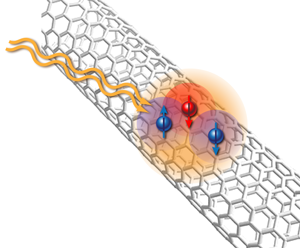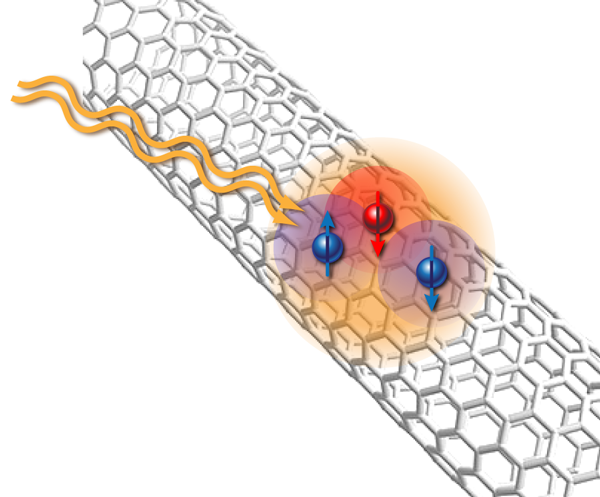A new quasiparticle in carbon nanotubes
Natural science progresses mostly because of unexpected observations. At times, however, experimental confirmation follows theoretical prediction. The quest for the Higgs particle at CERN is probably the most prominent current example of such a sequence. Solid-state physics, too, provides us with examples of particles that have been postulated but not yet observed in all expected scenarios. An example in semiconductors is a trion—a Coulomb-bound carrier complex of one electron and two holes (Fig. 1). Trions have been observed in a variety of systems, but surprisingly, in view of their rich prospects for device applications and basic research, not in semiconducting carbon nanotubes (CNTs). In a paper in Physical Review Letters [1], Ryusuke Matsunaga, Kazunari Matsuda, and Yoshihiko Kanemitsu, all at Kyoto University, Japan, report the first observation of trions in p-doped nanotubes. If confirmed by further experiments, this would be a major breakthrough in the field.
Carbon nanotubes—rolled cylinders of graphene a few nanometers in diameter—come in multiple shapes and sizes, and are either metallic or semiconducting, depending on the width of the ribbon and how it is rolled (twisted by one of the many possible discrete angles, or even untwisted). Most nanotubes are not fabricated; instead, they self assemble. Different species of nanotubes, such as those isolated in Matsunaga et al.’s experiment, can be distinguished by their optical fingerprints, similar to atoms and molecules. Nanotubes were first observed in 1991 [2], more than a decade before the discovery of graphene, and their study has since developed into a vast and rich research field, revealing their unique structural, electronic, and optoelectronic properties [3].
When a semiconductor absorbs a photon, an electron is promoted from the valence to the conduction band, leaving behind a hole in the electron sea that is described as an independent quasiparticle with positive charge. The photogenerated electron-hole pair can bind through attractive Coulomb forces to form a long-lived hydrogenlike carrier complex, named an exciton. It takes nanoseconds for the electron and the hole to annihilate and re-emit a photon. Exciton binding is typically enhanced in semiconductors of reduced dimensionality. An extreme case is found in nanotubes where the wave functions of the photogenerated carriers are spread over the circumference of the nanotube, and the electron and hole “see” each other across the tube. This intimate contact results in a strongly bound exciton that can move freely along the tube, with a binding energy typically of the order of several tenths of an electron volt.
Matsunaga et al. [1] proceed by attaching, through p-doping, an additional hole to the exciton. Similar to the ionized hydrogen molecule H2, which consists of two protons and one electron, the two holes and the electron form a Coulomb-bound carrier complex referred to as a charged exciton or trion. The neat thing about the trion is that it has a net charge and thus can be controlled by electrical gates. Trions could be also used for optical spin manipulation or to investigate the correlated carrier dynamics of one-dimensional Luttinger liquids—a peculiar state of strongly interacting systems in one dimension, where charge and spin density waves propagate independently at different group velocities—by optical means. Contrary to the H2 molecule, however, the electron and hole forming the trion have nearly identical masses. Therefore binding of the trion is mainly due to correlations—the restless dance of particles around each other—and the binding is expected to be rather weak. If it is too weak, trions would be unstable against Auger recombination—a process where an electron-hole pair recombines and the excess energy is passed to the surplus hole, which is about a 100 times faster than optical recombination [4].
The smoking gun of the trions in the experiment of Matsunaga et al. is the appearance of an additional peak in the optical spectra on the low-energy end of the exciton peak. Matsunaga et al. work hard to show that this peak indeed originates from trions and not, for example, from defects introduced through doping. They first investigate the influence of different dopants and doping concentrations and find that new peaks associated with trions in nanotubes appear at the same energy, regardless of the dopant species. They also become stronger with increasing doping concentration, along with a reduction of the exciton peak. Moreover, they find that excitons in nanotubes with different diameters and twist angles all come along with a corresponding trion partner and show clear “family patterns,” similar to those known for excitons in nanotubes. All this provides strong evidence for trions.
A striking feature of the experiments is the extremely large energy separation ( 0.1– 0.2eV) between the exciton and trion peaks, which the authors attribute to the large electron-hole exchange interaction in carbon-based materials. The exchange interaction accounts for the fact that the antisymmetric wave function keeps electrons with parallel spin orientations at bay, resulting in a lowering of the repulsive Coulomb energy. For the same reason, an optically excited electron-hole pair with opposite spin orientations (bright exciton) is less correlated than a pair where the hole spin is flipped (dark exciton), because the total number of spin-correlated valence and conduction band electrons differs by one. The resulting energy separation is denoted as the electron-hole exchange splitting, which is usually large for tightly confined carrier complexes such as excitons and trions in nanotubes. Matsunaga et al. speculate that this exchange interaction could lower the trion state’s energy below that of the dark exciton state and thus could make it a stable configuration, even at room temperature. Further work, both experimental and theoretical, is needed to resolve the issue of trion stability.
The authors stress that it was important to use samples with very few bundles of nanotubes to observe trions successfully. These bundles are not susceptible to being doped with holes and to doping-induced spectral changes, making it necessary to use particularly high-quality samples to observe the weak trion signals. The key to success was a novel dispersion technique for high-quality samples [5], together with ultracentrifugation—a technique by which polydisperse samples can be sorted in portions enriched in certain species—and a long time (up to seven hours) to exclude as many residual bundles as possible.
A colleague [6] notes that though more work is needed to unambiguously assign the new peaks to trions, this first observation of trions in carbon nanotubes seems to be a breakthrough. In any case, it provides an example of the discovery of new quasiparticles in solid-state systems, where the creators of materials remain the true heroes of the trade.
References
- R. Matsunaga, K. Matsuda, and Y. Kanemitsu, Phys. Rev. Lett. 106, 037404 (2011)
- S. Iijima, Nature 354, 56 (1991)
- Carbon Nanotubes: Advanced Topics in the Synthesis, Structure, Properties, and Applications, edited by A. Jorio et al. (Springer, Berlin, 2008)[Amazon][WorldCat]
- F. Wang et al., Phys. Rev. B 70, 241403 (2004)
- A. Nish et al., Nature Nanotech. 2, 630 (2007)
- A. Imamoglu (private communication)





